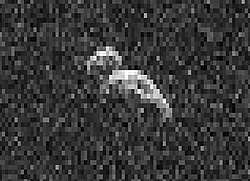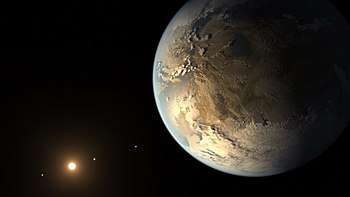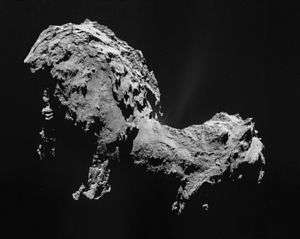List of asteroid close approaches to Earth in 2014
Below is the list of asteroid close approaches to Earth in 2014.
| Time of discovery of asteroids which came closer to Earth than the moon in 2014 |
|
Timeline of known close approaches less than one lunar distance from Earth in 2014
A list of known near-Earth asteroid close approaches less than 1 lunar distance (384,400 km or 0.00256 AU) from Earth in 2014.[note 1]
For reference, the radius of Earth is approximately 0.0000426 AU (6,370 km; 3,960 mi) or 0.0166 Lunar distances.
The orbit of geosynchronous satellites, however, is 0.000282 AU (42,200 km; 26,200 mi) or 0.110 Lunar distances. This year, 3 asteroids were detected which traveled nearer than this, most notably 2014 AA, which impacted. This list does not include any of the other 32 objects that collided with earth in 2014, none of which were discovered in advance, but were recorded by sensors designed to detect detonation of nuclear devices (of the 33 objects detected 5 had an impact energy greater than that of a 1 kiloton device) [1].
Rows highlighted red indicate objects which were not discovered until after closest approach
Rows highlighted yellow indicate objects discovered less than 24 hours before closest approach
Rows highlighted green indicate objects discovered more than one week before closest approach
Rows highlighted turquoise indicate objects discovered more than 7 weeks before closest approach
Rows highlighted blue indicate objects discovered more than one year before closest approach (i.e.
objects successfully cataloged on a previous orbit, rather than being detected during final approach)
| Date of closest approach |
Date discovered |
Object | Nominal geocentric distance (AU)[note 2] |
Nominal geocentric distance (LD) |
Size (m) (approx.) |
(H) (abs. mag) |
Closer approach to Moon |
Refs |
|---|---|---|---|---|---|---|---|---|
| 2014-01-01 | 2014-01-02 | 2014 AF5 | 0.00064 AU (96,000 km; 59,000 mi) | 0.25 | 5–10 | 28.8[2] | Yes | data · 2014 AF5 |
| 2014-01-02 | 2014-01-01 | 2014 AA | 0.000003 AU (450 km; 280 mi)(Impact)[3][4] | 0.001 (Impact) | 2–4 | 30.9 | data · 2014 AA | |
| 2014-01-08 | 2014-01-10 | 2014 AK51 | 0.00247 AU (370,000 km; 230,000 mi) | 0.96 | 15–30 | 26.6[5] | Yes | data · 2014 AK51 |
| 2014-01-09 | 2014-01-10 | 2014 AG51 | 0.000877 AU (131,200 km; 81,500 mi) | 0.34 | 2–5 | 29.9[6] | data · 2014 AG51 | |
| 2014-01-10 | 2014-01-10 | 2014 AW32 | 0.00124 AU (186,000 km; 115,000 mi) | 0.48 | 10–20 | 27.2[7] | data · 2014 AW32 | |
| 2014-02-21 | 2014-02-22 | 2014 DK10 | 0.00173 AU (259,000 km; 161,000 mi) | 0.67 | 7–16 | 27.8[8] | data · 2014 DK10 | |
| 2014-03-05 | 2014-02-28 | 2014 DX110 | 0.00233 AU (349,000 km; 217,000 mi) | 0.91 | 20–40 | 25.7[9] | data · 2014 DX110 | |
| 2014-03-06 | 2014-03-05 | 2014 EF | 0.00113 AU (169,000 km; 105,000 mi) | 0.44 | 4–9 | 29.0[10] | data · 2014 EF | |
| 2014-03-06 | 2014-03-05 | 2014 EC | 0.000412 AU (61,600 km; 38,300 mi) | 0.16 | 6–14 | 28.2[11] | data · 2014 EC | |
| 2014-03-09 | 2014-03-11 | 2014 EX24 | 0.00175 AU (262,000 km; 163,000 mi) | 0.68 | 5–11 | 28.7[12] | Yes | data · 2014 EX24 |
| 2014-03-30 | 2014-04-04 | 2014 GY44 | 0.00111 AU (166,000 km; 103,000 mi) | 0.43 | 20–50 | 25.4[13] | Yes | data · 2014 GY44 |
| 2014-04-03 | 2014-04-04 | 2014 GC49 | 0.000759 AU (113,500 km; 70,600 mi) | 0.30 | 5–11 | 28.6[14] | data · 2014 GC49 | |
| 2014-05-03 | 2014-04-28 | 2014 HL129 | 0.00195 AU (292,000 km; 181,000 mi) | 0.76 | 6–14 | 28.0[15] | data · 2014 HL129 | |
| 2014-05-07 | 2014-05-06 | 2014 JR24 | 0.000714 AU (106,800 km; 66,400 mi) | 0.28 | 3–8 | 29.3[16] | data · 2014 JR24 | |
| 2014-05-10 | 2014-05-10 | 2014 JG55 | 0.000676 AU (101,100 km; 62,800 mi) | 0.26 | 3–8 | 29.2[17] | data · 2014 JG55 | |
| 2014-05-26 | 2014-05-28 | 2014 KW76 | 0.00230 AU (344,000 km; 214,000 mi) | 0.89 | 6–14 | 28.0[18] | data · 2014 KW76 | |
| 2014-05-28 | 2014-05-27 | 2014 KC45 | 0.000590 AU (88,300 km; 54,800 mi) | 0.23 | 3–8 | 29.4[19] | data · 2014 KC45 | |
| 2014-06-03 | 2014-06-05 | 2014 LN17 | 0.00143 AU (214,000 km; 133,000 mi) | 0.54 | 10–20 | 27.2[20] | data · 2014 LN17 | |
| 2014-06-03 | 2014-06-02 | 2014 LY21 | 0.000111 AU (16,600 km; 10,300 mi) | 0.043 | 4–8 | 29.1[21] | ? | data · 2014 LY21 |
| 2014-06-22 | 2014-06-24 | 2014 MH6 | 0.00165 AU (247,000 km; 153,000 mi) | 0.64 | 10–23 | 27.0[22] | Yes | data · 2014 MH6 |
| 2014-07-24 | 2014-07-25 | 2014 OP2 | 0.00134 AU (200,000 km; 125,000 mi) | 0.52 | 4–9 | 29.0[23] | data · 2014 OP2 | |
| 2014-07-25 | 2014-07-26 | 2014 OM207 | 0.00180 AU (269,000 km; 167,000 mi) | 0.70 | 4–9 | 29.0[24] | data · 2014 OM207 | |
| 2014-08-31 | 2014-09-01 | 2014 RA | 0.000379 AU (56,700 km; 35,200 mi) | 0.15 | 5–10 | 28.8[25] | data · 2014 RA | |
| 2014-09-07 | 2014-09-01 | 2014 RC | 0.000267 AU (39,900 km; 24,800 mi) | 0.10 | 11–25 | 26.8[26] | data · 2014 RC | |
| 2014-09-20 | 2014-09-20 | 2014 SG1 | 0.000532 AU (79,600 km; 49,500 mi) | 0.21 | 4–9 | 29.0[27] | data · 2014 SG1 | |
| 2014-10-01 | 2014-10-02 | 2014 TL | 0.000656 AU (98,100 km; 61,000 mi) | 0.26 | 8–17 | 27.6[28] | data · 2014 TL | |
| 2014-10-19 | 2014-10-24 | 2014 UU56 | 0.00174 AU (260,000 km; 162,000 mi) | 0.66 | 7–15 | 28.0[29] | data · 2014 UU56 | |
| 2014-10-27 | 2014-10-25 | 2014 UF56 | 0.00110 AU (165,000 km; 102,000 mi) | 0.43 | 8–19 | 27.4[30] | data · 2014 UF56 | |
| 2014-11-13 | 2014-11-17 | 2014 WE6 | 0.00147 AU (220,000 km; 137,000 mi) | 0.57 | 2–5 | 30.3[31] | Yes | data · 2014 WE6 |
| 2014-11-15 | 2014-11-17 | 2014 WJ6 | 0.00223 AU (334,000 km; 207,000 mi) | 0.86 | 9–23 | 27.1[32] | Yes | data · 2014 WJ6 |
| 2014-12-07 | 2014-11-24 | 2014 WX202 | 0.00251 AU (375,000 km; 233,000 mi) | 0.98 | 3–7 | 29.4[33] | Yes | data · 2014 WX202 |
| 2014-12-26 | 2014-12-27 | 2014 YR14 | 0.00233 AU (349,000 km; 217,000 mi) | 0.91 | 16–35 | 26.1[34] | data · 2014 YR14 |
Notes
- For a list of current Earth close approaches see NEO Earth Close Approaches
- Distance from the center of Earth to the center of the object. See the NASA/JPL Solar System Dynamics Glossary: Geocentric. Earth has a radius of approximately 6,400 km.
Timeline of close approaches less than one Lunar distance from the Moon in 2014
The number of asteroids listed here are significantly less than those of asteroids approaching Earth for several reasons:
- Asteroids approaching Earth not only move faster, but are brighter and are easier to detect with modern surveys due to these factors
- Asteroids approaching closer to Earth are higher priority to confirm, and only confirmed asteroids are listed with a lunocentric approach distance
- Those which make close approaches to the Moon are frequently lost in its glare, making them harder to confirm, and are more easily discovered during the new Moon, when the Moon is too close to the Sun for any asteroids to be detected while they are near to the Moon anyway.
These factors combined severely limit the amount of Moon-approaching asteroids, to a level many times lower than the detected asteroids to pass just as close to Earth instead.
| Date of closest approach |
Object | Nominal lunocentric distance (AU)[note2 1] |
Nominal lunocentric distance (LD) |
Size (m) (approximate) |
(H) | approach distance to Earth (LD) |
|---|---|---|---|---|---|---|
| 2014-01-01 | 2014 AF5 | 0.000625 AU (93,500 km; 58,100 mi) | 0.24 | 4–12 | 28.8[2] | 0.25 |
| 2014-01-02 | 2014 AA | 0.00238 AU (356,000 km; 221,000 mi) | 0.93[note2 2] | 1–5 | 30.9[35] | impact |
| 2014-01-07 | 2014 AK51 | 0.00142 AU (212,000 km; 132,000 mi) | 0.55 | 10–33 | 26.6[5] | 0.96 |
| 2014-01-08 | 2014 AD16 | 0.00244 AU (365,000 km; 227,000 mi) | 0.95 | 7–23 | 27.4[36] | 1.50 |
| 2014-01-09 | 2014 AG51 | 0.00238 AU (356,000 km; 221,000 mi) | 0.93 | 2–7 | 29.9[6] | 0.34 |
| 2014-01-10 | 2014 AW32 | 0.00218 AU (326,000 km; 203,000 mi) | 0.85 | 7–22 | 27.5[7] | 0.48 |
| 2014-03-05 | 2014 DX110 | 0.00250 AU (374,000 km; 232,000 mi) | 0.97 | 15–49 | 25.7[9] | 0.91 |
| 2014-03-06 | 2014 EC | 0.00257 AU (384,000 km; 239,000 mi) | 0.9992 | 5–16 | 28.2[11] | 0.16 |
| 2014-03-09 | 2014 EX24 | 0.00164 AU (245,000 km; 152,000 mi) | 0.64 | 4–13 | 28.6[12] | 0.68 |
| 2014-03-17 | 2014 FE | 0.00232 AU (347,000 km; 216,000 mi) | 0.90 | 7–24 | 27.3[37] | 1.10 |
| 2014-03-29 | 2014 GY44 | 0.000250 AU (37,400 km; 23,200 mi) | 0.097 | 18–57 | 25.4[13] | 0.43 |
| 2014-05-10 | 2014 JG55 | 0.00216 AU (323,000 km; 201,000 mi) | 0.84 | 3–10 | 29.2[17] | 0.26 |
| 2014-05-28 | 2014 KC45 | 0.00171 AU (256,000 km; 159,000 mi) | 0.67 | 3–9 | 29.3[19] | 0.23 |
| 2014-06-03 | 2014 LN17 | 0.00201 AU (301,000 km; 187,000 mi) | 0.78 | 8–27 | 27.0[20] | 0.54 |
| 2014-06-04 | 2014 LY21 | 0.00108 AU (162,000 km; 100,000 mi) | 0.42 | 3–10 | 29.1[21] | 0.043 |
| 2014-06-22 | 2014 MH6 | 0.000956 AU (143,000 km; 88,900 mi) | 0.37 | 8–26 | 27.1[22] | 0.64 |
| 2014-08-31 | 2014 RA | 0.00203 AU (304,000 km; 189,000 mi) | 0.79 | 4–11 | 28.9[25] | 0.15 |
| 2014-09-07 | 2014 RC | 0.000845 AU (126,400 km; 78,500 mi) | 0.33 | 9–30 | 26.8[26] | 0.10 |
| 2014-09-20 | 2014 SG1 | 0.00205 AU (307,000 km; 191,000 mi) | 0.80 | 3–10 | 29.1[27] | 0.21 |
| 2014-10-01 | 2014 TL | 0.00191 AU (286,000 km; 178,000 mi) | 0.74 | 6–19 | 27.8[28] | 0.26 |
| 2014-10-27 | 2014 UF56 | 0.00137 AU (205,000 km; 127,000 mi) | 0.53 | 7–23 | 27.4[30] | 0.43 |
| 2014-11-13 | 2014 WE6 | 0.00122 AU (183,000 km; 113,000 mi) | 0.48 | 2–6 | 30.4[31] | 0.57 |
| 2014-11-15 | 2014 WJ6 | 0.00181 AU (271,000 km; 168,000 mi) | 0.70 | 8–26 | 27.1[32] | 0.86 |
| 2014-12-04 | 2014 WX202 | 0.00148 AU (221,000 km; 138,000 mi) | 0.58 | 3–8 | 29.6[33] | 0.98 |
Notes
- Distance from the center of the Moon to the center of the object. the Moon has a radius of approximately 1,740 km.
- if 2014 AA had not hit Earth, it would have traveled much closer to the Moon
Additional examples

An example list of near-Earth asteroids that passed more than 1 lunar distance (384,400 km or 0.00256 AU) from Earth in 2014.
- (388188) 2006 DP14 (~300 meters in diameter) passed 6.2 lunar distances from Earth on 10 February 2014.
- 2000 EM26 (~200 meters in diameter) passed more than 0.018 AU (2,700,000 km; 1,700,000 mi) from Earth on 17–18 February 2014.
- 2014 HJ197 (~3 meters in diameter) may have passed as close as 0.97 lunar distances (371,000 km) from Earth (0.68 lunar distances (261,000 km) from the Moon on either April 14 or 15th, 2014, but the nominal orbit calculates an approach of 1.29 lunar distances (495,000 km) from Earth (1.23 lunar distances (473,000 km) from the Moon).
- 2014 KH39 (~25 meters in diameter) passed 1.1 lunar distances from Earth on 3 June 2014.[38]
- 2014 HQ124 (~325 meters in diameter) passed 3.25 lunar distances from Earth on 8 June 2014.
- 2014 OO6 (~75 meters in diameter) passed 0.0297 AU (4,440,000 km; 2,760,000 mi) from Earth on 18 August 2014.
- 2014 XL7 (~230 meters in diameter) passed roughly 0.26 AU (39,000,000 km; 24,000,000 mi) from Earth on 1 September 2014.
- The orbit of 2009 RR (20–45 meters in diameter) with an observation arc of only 4 days predicted that it could pass just inside 1 lunar distance on 2014-09-16, but the orbital uncertainties show that it could have passed as much as 0.1 AU (15,000,000 km; 9,300,000 mi) from Earth.[39]
- 2014 SN142 (~10 meters in diameter) passed 1.1 lunar distances from Earth on 23 September 2014.[40]
- 2014 SC324 (~60 meters in diameter) passed 1.5 lunar distances from Earth on 24 October 2014.[41]
See also
References
- "Fireballs".
- "JPL Small-Body Database Browser: (2014 AF5)" (last observation: 2014-01-03). Retrieved 2014-01-06.
- Farnocchia, Davide; Chesley, Steven R.; Brown, Peter G.; Chodas, Paul W. (1 August 2016). "The trajectory and atmospheric impact of asteroid 2014 AA". Icarus. 274: 327–333. Bibcode:2016Icar..274..327F. doi:10.1016/j.icarus.2016.02.056.
- de la Fuente Marcos, C.; de la Fuente Marcos, R.; Mialle, P. (13 October 2016). "Homing in for New Year: impact parameters and pre-impact orbital evolution of meteoroid 2014 AA". Astrophysics and Space Science. 361 (11): 358 (33 pp.). arXiv:1610.01055. Bibcode:2016Ap&SS.361..358D. doi:10.1007/s10509-016-2945-3.
- "JPL Small-Body Database Browser: (2014 AK51)" (last observation: 2014-01-13).
- "JPL Small-Body Database Browser: (2014 AG51)" (last observation: 2014-01-11).
- "JPL Small-Body Database Browser: (2014 AW32)" (last observation: 2014-01-11).
- "JPL Small-Body Database Browser: (2014 DK10)" (last observation: 2014-02-24).
- "JPL Small-Body Database Browser: (2014 DX110)" (last observation: 2014-03-05).
- "JPL Small-Body Database Browser: (2014 EF)" (last observation: 2014-03-05).
- "JPL Small-Body Database Browser: (2014 EC)" (last observation: 2014-03-05).
- "JPL Small-Body Database Browser: (2014 EX24)" (last observation: 2014-03-12).
- "JPL Small-Body Database Browser: (2014 GY44)" (last observation: 2014-04-09).
- "JPL Small-Body Database Browser: (2014 GC49)" (last observation: 2014-04-05).
- "JPL Small-Body Database Browser: (2014 HL129)" (last observation: 2014-04-29).
- "JPL Small-Body Database Browser: (2014 JR24)" (last observation: 2014-05-07).
- "JPL Small-Body Database Browser: (2014 JG55)" (last observation: 2014-05-10).
- "JPL Small-Body Database Browser: (2014 KW76)" (last observation: 2014-05-30).
- "JPL Small-Body Database Browser: (2014 KC45)" (last observation: 2014-05-28).
- "JPL Small-Body Database Browser: (2014 LN17)" (last observation: 2014-06-07).
- "JPL Small-Body Database Browser: (2014 LY21)" (last observation: 2014-06-02).
- "JPL Small-Body Database Browser: (2014 MH6)" (last observation: 2014-06-25).
- "JPL Small-Body Database Browser: (2014 OP2)" (last observation: 2014-06-28).
- "JPL Small-Body Database Browser: (2014 OM207)" (last observation: 2014-06-29).
- "JPL Small-Body Database Browser: (2014 RA)" (last observation: 2014-09-02).
- "JPL Small-Body Database Browser: (2014 RC)" (last observation: 2014-09-07).
- "JPL Small-Body Database Browser: (2014 SG1)" (last observation: 2014-09-20).
- "JPL Small-Body Database Browser: (2014 TL)" (last observation: 2014-10-02).
- "JPL Small-Body Database Browser: (2014 UU56)" (last observation: 2014-10-26).
- "JPL Small-Body Database Browser: (2014 UF56)" (last observation: 2014-10-26).
- "JPL Small-Body Database Browser: (2014 WE6)" (last observation: 2014-11-21).
- "JPL Small-Body Database Browser: (2014 WJ6)" (last observation: 2014-11-19).
- "JPL Small-Body Database Browser: (2014 WX202)" (last observation: 2014-11-26).
- "JPL Small-Body Database Browser: (2014 YR14)" (last observation: 2014-12-27).
- "JPL Small-Body Database Browser: (2014 AA)" (last observation: 2014-01-02).
- "JPL Small-Body Database Browser: (2014 AD16)" (last observation: 2014-01-06).
- "JPL Small-Body Database Browser: (2014 FE)" (last observation: 2014-03-24).
- B. King - Asteroid 2014 KH39 Zips Just 1.1 LD from Earth - Universe Today
- "JPL Small-Body Database Browser: (2009 RR)" (last observation: 2009-09-15; arc: 4 days).
- "JPL Small-Body Database Browser: (2014 SN142)" (last observation: 2014-09-22).
- "JPL Small-Body Database Browser: (2014 SC324)" (last observation: 2014-10-24).



